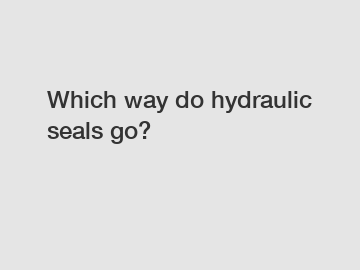Which way do hydraulic seals go?
You will get efficient and thoughtful service from King Seal.
Which Way Do Hydraulic Seals Go? A Comprehensive Guide to Understanding the Proper Orientation.
Hydraulic seals are essential components used in various mechanical systems to prevent the leakage of fluids and maintain operational efficiency. However, one common question that arises when installing hydraulic seals is, "Which way do hydraulic seals go?" The correct positioning of these seals significantly impacts their effectiveness and longevity. In this article, we will explore this topic in-depth and provide you with a comprehensive guide to understanding the proper orientation of hydraulic seals.

1. Importance of Proper Orientation:
The correct installation of hydraulic seals is pivotal to ensure optimal performance of hydraulic systems. When seals are improperly installed, it can result in fluid leakages, system malfunctions, and even catastrophic failures. Thus, it is crucial to understand the importance of proper orientation to maximize the functionality and lifespan of hydraulic seals.
2. Bidirectional vs. Unidirectional Seals:
Hydraulic seals can either be bidirectional or unidirectional, depending on their design and intended application. Bidirectional seals can function in either direction, making them suitable for applications where the fluid pressure can fluctuate or reverse during operation. On the other hand, unidirectional seals are designed to work in a specific direction, allowing fluid to flow in one direction while blocking it in the opposite direction.
3. Lip Seal Orientation:
One common type of hydraulic seal is the lip seal, also known as a radial shaft seal. Lip seals are primarily used to prevent the leakage of fluids along the rotating shafts of hydraulic cylinders or pumps. When installing a lip seal, it is crucial to ensure that the lip faces the fluid or the side from which the seal encounters pressure. This orientation enables the seal to effectively contain the fluid and prevent leakage.
4. Directional Arrows and Markings:
Manufacturers often provide directional marking or arrows on hydraulic seals to indicate the proper orientation during installation. These markings serve as valuable guidelines and must be followed meticulously. The direction indicated by the arrows should align with the fluid flow for optimal performance. Neglecting these markings can compromise the effectiveness of the seal and lead to unexpected failures.
5. Consideration of Seal Design:
When determining the correct orientation of hydraulic seals, it is essential to consider their specific design features. Some seals may have additional components, such as anti-extrusion rings or backup rings, which must be positioned correctly to ensure their intended functionality. Carefully examining the design and accompanying documentation can provide valuable insights into the correct orientation of these additional elements.
6. Understanding Application Requirements:
Each hydraulic system is unique, and the requirements for seal orientation may vary accordingly. It is crucial to thoroughly understand the specific application and hydraulic system's operating conditions. Factors such as fluid pressure, temperature, and speed can influence the orientation of hydraulic seals. Consulting system manuals or seeking professional advice can help determine the ideal orientation for the seals in a particular application.
7. Installation Best Practices:
Following proper installation practices is essential to achieve the correct orientation of hydraulic seals. Before installation, clean the sealing surfaces thoroughly to prevent contamination, which can compromise seal effectiveness. Additionally, inspect the seal and the installation cavity for any damages or irregularities that may affect the seal's performance. Employing the recommended installation tools and techniques will ensure a secure fit and proper alignment.
8. Regular Inspection and Maintenance:
Once hydraulic seals are installed, regular inspection and maintenance are crucial to ensuring their continued functionality. Over time, seals may wear out or become damaged due to the demanding operating conditions they are subjected to. Promptly addressing any signs of leakage, wear, or damage can prevent major failures and extend the lifespan of hydraulic seals.
9. The Consequences of Incorrect Installation:
Failure to properly orient hydraulic seals can result in severe consequences. Fluid leakages can lead to system inefficiencies, increased energy consumption, equipment damage, and potential hazards for personnel working in the vicinity. Moreover, the costs associated with repairing or replacing faulty seals can be substantial. Therefore, investing time and effort into understanding and implementing correct orientations is vital to avoid these potential problems.
In conclusion, understanding the proper orientation of hydraulic seals is crucial for their successful installation and optimal performance. Bidirectional and unidirectional seals each have specific purposes, and their orientation must align with the intended fluid flow. Directional arrows and markings, seal design considerations, and comprehending application requirements play significant roles in determining the correct orientation. By employing installation best practices, conducting regular inspections, and addressing any issues promptly, the longevity and effectiveness of hydraulic seals can be maximized. Remember that proper orientation not only ensures leak-free operations but also contributes to the overall reliability and safety of hydraulic systems.
Please visit our website for more information on this topic.
Contact us to discuss your requirements of custom o-ring manufacturer. Our experienced sales team can help you identify the options that best suit your needs.



